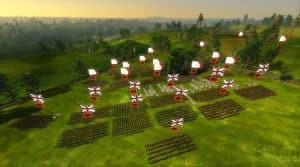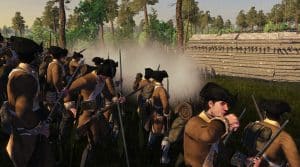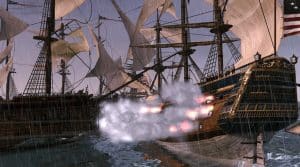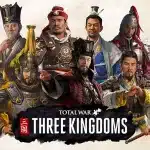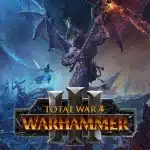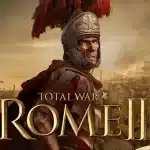Total War: EMPIRE
Related Games
Description
🔥 What is Total War: Empire for PC
Total War: Empire is a grand strategy game developed by Creative Assembly and published by SEGA, and it stands as one of the most ambitious entries in the Total War series. Released in 2009, it marked a significant leap for the franchise by introducing real-time naval battles, a vast global campaign map, and a focus on the 18th century, an era defined by enlightenment, revolution, and colonial expansion. Unlike earlier titles in the series, Empire spans continents, allowing players to manage sprawling empires across Europe, the Americas, India, and the trade routes of the wider world.
The game places you in the role of a ruler or general of a major nation during this turbulent period, where political intrigue, military conquest, and economic development are inseparably linked. You are tasked not only with commanding armies in large-scale land battles but also with managing diplomacy, trade, technology, and the balance of power across multiple theaters. The overarching goal is to dominate global politics through military might, economic influence, or political reform, creating a multifaceted strategy experience unlike anything before it.
Empire also brought significant innovations to the franchise’s mechanics, with improved city management, a deeper technology tree, and the inclusion of colonies that demanded constant attention and protection. It successfully blended the thrill of tactical warfare with the slow burn of empire-building, while offering players a sweeping canvas of history to reshape according to their ambitions.
👉 Features of Total War: Empire
Vast Global Campaign Map
Empire features a campaign map that covers multiple continents, making it one of the most expansive entries in the series. Players can fight for dominance in Europe, expand colonies in North and South America, protect trade routes in the Caribbean, and engage in fierce battles in India. This global approach not only widens strategic possibilities but also forces players to juggle resources and military commitments across distant territories.
Real-Time Naval Battles
For the first time in the franchise, Empire introduced fully playable naval battles in real-time. These engagements allow players to control individual ships, maneuvering with wind direction and broadside cannons to sink or capture enemy fleets. Naval supremacy plays a critical role, as controlling sea routes means safeguarding trade and ensuring the smooth flow of resources essential for empire survival.
Technology and Enlightenment
A major addition is the extensive technology tree, reflecting the Enlightenment era’s intellectual and industrial revolutions. Players can research military, naval, industrial, and social technologies that dramatically affect gameplay. Innovations such as improved firearms, agricultural methods, and political philosophies give new dimensions to empire management, often forcing players to balance rapid progress with the risks of social upheaval.
Diverse Nations and Cultures
Empire allows players to choose from a wide variety of factions, each with its own strengths, weaknesses, and unique units. Whether commanding Britain’s naval power, France’s influence in Europe, the Ottoman Empire’s vast territories, or the Maratha Confederacy’s dynamic rise in India, the diversity of factions ensures replayability and radically different strategies with every campaign.
Revolutionary Politics
The game features dynamic political systems, where monarchies can be overthrown and republics established through revolution. These internal conflicts add tension to campaigns, as managing unrest becomes as important as defeating foreign enemies. Choosing between reform, suppression, or revolution is often a decisive element in shaping the future of your empire.
Gameplay
Campaign Strategy and Empire Management
The heart of Empire lies in its campaign map, where players oversee provinces, taxation, trade, and diplomacy. Each region provides unique resources, while colonies require investment in infrastructure and protection from rival powers. Diplomacy is deeper than in earlier games, allowing alliances, trade agreements, and puppet states to be negotiated and broken depending on circumstances.
Military Engagements on Land
Land battles retain the real-time strategy hallmark of the Total War series but with a distinct 18th-century flavor. Infantry now rely heavily on line formations and musket volleys, cavalry play vital roles in flanking maneuvers, and artillery has greater destructive power. The slow reload times of muskets force players to carefully plan formations and positioning, making tactical foresight more important than raw aggression.
Naval Supremacy and Trade Routes
Empire’s naval battles are not just flashy spectacles; they are central to global dominance. Fleets can block trade routes, protect colonial outposts, and secure overseas supply lines. Wind mechanics and ship types add tactical depth, making naval engagements both strategic and cinematic. Successful players often realize that maritime control is just as important as victories on land.
Technological Progression and Social Change
The Enlightenment brings a dual-edged sword to gameplay: technological growth can empower armies and economies, but it can also inspire revolutionary movements at home. Players must decide whether to embrace change, risking instability, or cling to tradition at the cost of progress. This dynamic makes every research decision feel impactful, tying long-term development directly to the player’s political and military survival.
Missions and Objectives
Each campaign is enriched with missions that guide expansion, conquest, or political reform. These objectives not only provide structure but also reward players with resources, units, or diplomatic advantages. However, the sandbox nature of the game ensures players always have freedom to pursue their own path, whether by building a mercantile empire or waging a relentless war of domination.
Graphics
Realistic Battlefields and Naval Warfare
Empire’s graphics were groundbreaking at release, with battlefields stretching into the horizon and hundreds of soldiers fighting in formation. The game’s naval battles remain particularly striking, with ships rendered in stunning detail, sails catching wind realistically, and cannon fire erupting across the sea. The smoke and chaos of these clashes immerse players in the brutal reality of 18th-century warfare.
Diverse Environments Across Continents
The global campaign ensures visual variety, with lush European farmlands, arid deserts of the Middle East, dense Indian jungles, and colonial towns in the Americas. Each environment feels distinct and contributes to immersion, reinforcing the idea of ruling over a truly global empire.
Animations and Atmospheric Effects
Infantry reload animations, cavalry charges, and cannon barrages are rendered with remarkable detail, making battles feel alive and authentic. Atmospheric effects like rolling smoke from musket volleys or ships breaking apart under fire enhance the cinematic presentation, giving every battle a sense of weight and realism.
Campaign Map Presentation
The campaign map is richly detailed, with dynamic seasons, shifting weather, and visually distinct regions. The cities, ports, and trade nodes are all represented in ways that make strategic planning easier while maintaining an aesthetic that feels historically grounded and visually appealing.
Pros and Cons
✔️ Pros
- Ambitious global scale with multiple continents and factions to manage.
- First Total War title with fully playable naval battles, adding strategic depth.
- Rich technology tree reflecting the Enlightenment era.
- Detailed and atmospheric graphics that enhance immersion in battles.
- Political and social systems that allow revolutions and government changes.
❌ Cons
- AI can be inconsistent, with questionable tactical and diplomatic decisions.
- Naval battles, while innovative, can feel slow or repetitive for some players.
- Campaign map can become overwhelming due to the sheer number of regions.
- Performance issues at release, with occasional bugs and crashes still affecting large campaigns.
ℹ️ Game information
⭐ Installation Instructions
- The game is fully complete, you just need to install it, so there is no need to unpack it or download it from other sources.
- Just run the Total War: EMPIRE.exe installation file.
- Simply launch the game from shortcut desktop.
⚙️ System Requirements
✅ Minimum:
- OS: Windows XP/Vista
- Processor: 2.4 GHz Intel® Pentium®
- Memory: 1 GB RAM
- Graphics: 256 MB DirectX 9.0c compatible
- DirectX: Version 9.0c
- Network: Broadband Internet connection
- Storage: 15 GB available space
Images
